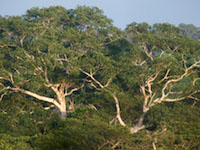03 Feb 09 - Hotel Mirador Rio Blanco, Los Bancos
Up at 3:45 AM for breakfast at Tandayapa Lodge. Then a 1.25 hour ride over a battered, muddy road to a paved road. The road washouts continue to plague us, although so far it's only been delays, not missed locations. Then a long drive to the access road to Rio Silanche. The access road goes through a gravel and rock quarry. There's a lot of roads being repaired. So we birded with dump trucks roaring by. Still, the birding was very good, and the daily species count the best so far. Trogons and Tanagers were especially good, although the creek-side Neotropical Coromorant, Green Kingfisher and Striated Heron were a treat.
This was the first day it was really hot. I have no idea what the final temperature was, but it was a five water bottle day. I know José had planned to get us here earlier, but the combination of the detours and decent birding walking in caused delays. Rio Silanche itself is about 200 acres of Choço lowlands and foothills. The trails at Rio Silanche are laid out in a grid pattern that allows you to intercept a bird a second time; convenient. The Rio Silanche runs through the area, but from what we saw wasn't particularly birdy in comparison to the stretches on the walk in.
There's a nice canopy 50 foot tall tower that gets you up into the upper story. By the time we got to the tower it was pretty hot and the forest was fairly quiet. But we did have nice views of a Choço Toucan and Pale-billed Aracrai. And our first Three-toed Sloth.
In one part of the Reserve, there's a very nice effort to take some former pasture and transform it into a model shade-grown coffee farm. We had some very nice mixed flocks in that area.
The hotel has nice feeders that attract a variety of tanagers, woodpeckers and hummingbirds. The human feeders aren't bad, either; excellent food and, once again, the superb Ecuadoran soups.
|
04 Feb 09 - Hotel Mirador Rio Blanco, Los Bancos
Our second night at H. Mirador Rio Blanco. We were up at 4:30 AM for a short ride to Refugio Paz de las Antpittas and the fabulous Maria, the Giant Antpitta. Even in distant Fairbanks, we have heard of Angel Paz, the Antpitta Whisperer.
The drive was short but the road was intense; I've seen stream beds that were in better condition. Our wheezy, tired J. L. Tourismo bus just barely made it.
In near total darkness we walked first down a trail to an Andean Cock-of-the-Rock lek. We had a few brief glimpses of two males, and an even briefer display of lekking. The light was hopelessly low, but I did shoot a few photos of this very strange bird.
Then we climbed up a bit in early morning light to watch Angel Paz call in Maria, indisputably the most famous Giant Antpitta in the world. A few calls of "Maria, venga" and Maria appeared for chopped earthworms and several hundred photographs. An antpitta whisperer, indeed. A little later, Angel called in a second Giant Antpitta, who was a bit shyer. Angel led us next down to a mountain stream at the bottom of the ridge, where he called in a White-bellied Antpitta. We birded our way out, hearing but not seeing various antbirds. We had coffee and very nice pastries with Angel's family, which included boot-cleaning by his children. And then we push-started the bus, whose starting motor has quit. We had help from Angel's new car, purchased with revenue generated by Maria. Ordinarily I wouldn't be a fan of food conditioning wild birds. But two things change my opinion here. First, antpittas, as a group, are famously hard to see. Second, and more importantly, Angel is personally motivated to take very good care of his land, keep it wild and keep it suitable for "his" birds. And his financial success may be a good role model for others. He has apprentices he has trained. Apparently, we will meet one later.
We had a long lunch back at H. Mirador Rio Blanco, and then Wendy and the guys headed back to Rio Silanche. Just about the time we got to the canopy tower, it started to rain, a real tropical rainstorm, where the foot immediately above the ground dissolves into a muddy blur. We tried to wait it out, but by 5:30 PM it was obvious that the rain wasn't quitting and we sprinted back to the bus, got it started on a downhill run, and headed back.
I had a major equipment failure this afternoon at Rio Silanche: the bayonet mount on my 300mm f2.8 lens, by far my favorite glass, lost two of the four screws that hold it on. I was able to find one of the screws, but the lens is out of commission until I can find a photo repair shop or, at a minimum, a jeweller's screwdriver. I had to fall back to the less than adequate 90-300mm f4.5-5.6. It's fuzzy, won't work well with a teleconverter, needs full daylight and is hard to focus. But it will have to do.
|

